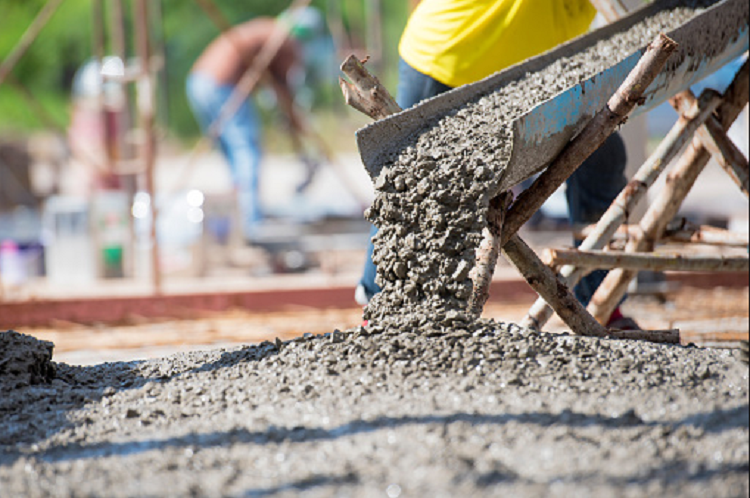Table of Contents
Concrete is a durable and versatile material used in several buildings worldwide.
It is considered the most widely used man-made material because nearly all homes and commercial buildings use concrete for their foundations, driveways, and patios.
This material combines cement and aggregates such as sand, gravel, limestone, and water. All these components are mixed, and as the water dries, the heavily compressed mixture solidifies, creating a new stone-like material.
The early Romans were the first to use concrete, similar to how we used it today. They used it for basically every structure around them, from bathhouses to aqueducts and even the Colosseum. Several of these structures still survive today, owing their longevity to the components of the concrete used to build them.
Modern reinforced concrete can last for years without major repairs or replacement. However, when used for structures such as patios and driveways, they can be worn down and damaged due to people and vehicles moving around the area. Activities such as backyard camping, exposure to stains and chemicals, and the heat of the sun and rains can cause this concrete to fade and be damaged. Likewise, even if the concrete seems solid, it still has cracks and holes on its surface. It is where moisture from the rain or melting snow can seep through, causing mold to form and further weakening the structure.
Concrete in driveways and patios can perform quite well even if not sealed at all. Still, most experts recommend applying a good quality concrete sealer once or twice yearly to improve the concrete’s durability and appearance.
A concrete sealer is a material that creates a firm protective layer that protects the concrete from weather exposure, stains, abrasion, and other chemicals. Concrete sealers are available in various colors and leave a glossy appearance, which can match the theme and help bring out the natural beauty of your property. Applying a concrete sealer is relatively simple and straightforward and could last a few hours, but its effects could help extend the life of a concrete driveway or patio.
Before starting a concrete sealing project, it is essential to identify the different types of concrete sealers to know which product suits your needs and requirements.
Acrylic resin sealers are considered one of the most common types of concrete sealers as they are easy to apply, affordable, and convenient for outdoor use. These types of sealers use acrylic resin, a plastic substance that dries into an air-tight and hard protective film over the concrete and protects it from moisture. Some acrylic resin sealers may turn slightly yellow when exposed to direct sunlight, especially when mixed with silicon. Experts recommend using pure acrylic resin as it is non-yellowing and lasts longer than other acrylic sealers.
Another type of sealer is epoxy or polyurethane concrete sealer. is another type of sealerThese sealers form a thick protective film on the surface, creating an abrasion-resistant and tough finish. Compared to acrylic sealers, epoxy sealers offer better water repellence for porous construction materials such as concrete. Epoxy or polyurethane concrete sealers seal surface pores impenetrable to oil stains, liquid, or moisture. It also prevents corrosion caused by industrial chemicals such as solvents and lubricants.
Epoxies bind well to concrete and provide a clean finish, but as they are non-porous, they do not allow trapped liquid to escape. As these materials prevent moisture from evaporating, a white haze may form between the concrete and the sealed layer. Patio or driveways coated with epoxies tend to be slippery; therefore, it is the best choice for concrete countertops.
The last type of concrete sealer is known as a penetrating sealer. As its name implies, these sealers are made of specialty resins such as silicones and silanes that form a protective layer against oil, moisture, and other chemicals. As they can seal the concrete pores below the surface, penetrating sealers offer the deepest and longest-lasting protection among the other concrete sealers. Most products are breathable, which means that moisture can evaporate from them. As they provide excellent protection against harsh weather conditions without changing the surface appearance, penetrating sealers are highly recommended for outdoor use.
Protecting your concrete as soon as it finishes the curing period at about 28 days is recommended. Experts suggest checking the weather forecast for the next few days as the process should be performed when the environment is warm and dry.
Before sealing, the following steps must be accomplished beforehand to prepare your driveway or patio.
- Ensure to clean the area thoroughly. Sweep, mop, and remove debris, dust, loose concrete particles, grease, and dirt from the concrete surface. Remove any existing concrete sealer using a solvent-based stripper. Failure to thoroughly clean the space can permanently seal the dust and stains, making them almost impossible to remove when it completely dries up.
- When applying a concrete sealant, the coating must be able to adhere to the concrete. Therefore, a process called concrete etching must be conducted. It is a method of applying an acid and water solution to a concreted area to roughen its surface. As the acid washes and opens up the pores of the concrete, it ensures the strong adhesion of the new concrete sealant. Allow the concrete to dry for 24 hours before applying the sealer.
Now, you are ready to apply the concrete sealant. Using a roller or a sprayer, apply a thin coat of concrete sealant on the concrete. The application tool, whether to use a roller or sprayer, depends on the type of sealant you choose. Always refer to the manufacturer’s manual for suggestions. Allow the first coat to dry for a couple of hours before applying the second one. Apply the second coat opposite the first to ensure a better and more consistent scope.
Concrete sealant usually dries in a couple of days or more. It is crucial to refer to the manufacturer’s indicated drying period before passing by or driving in the area.

